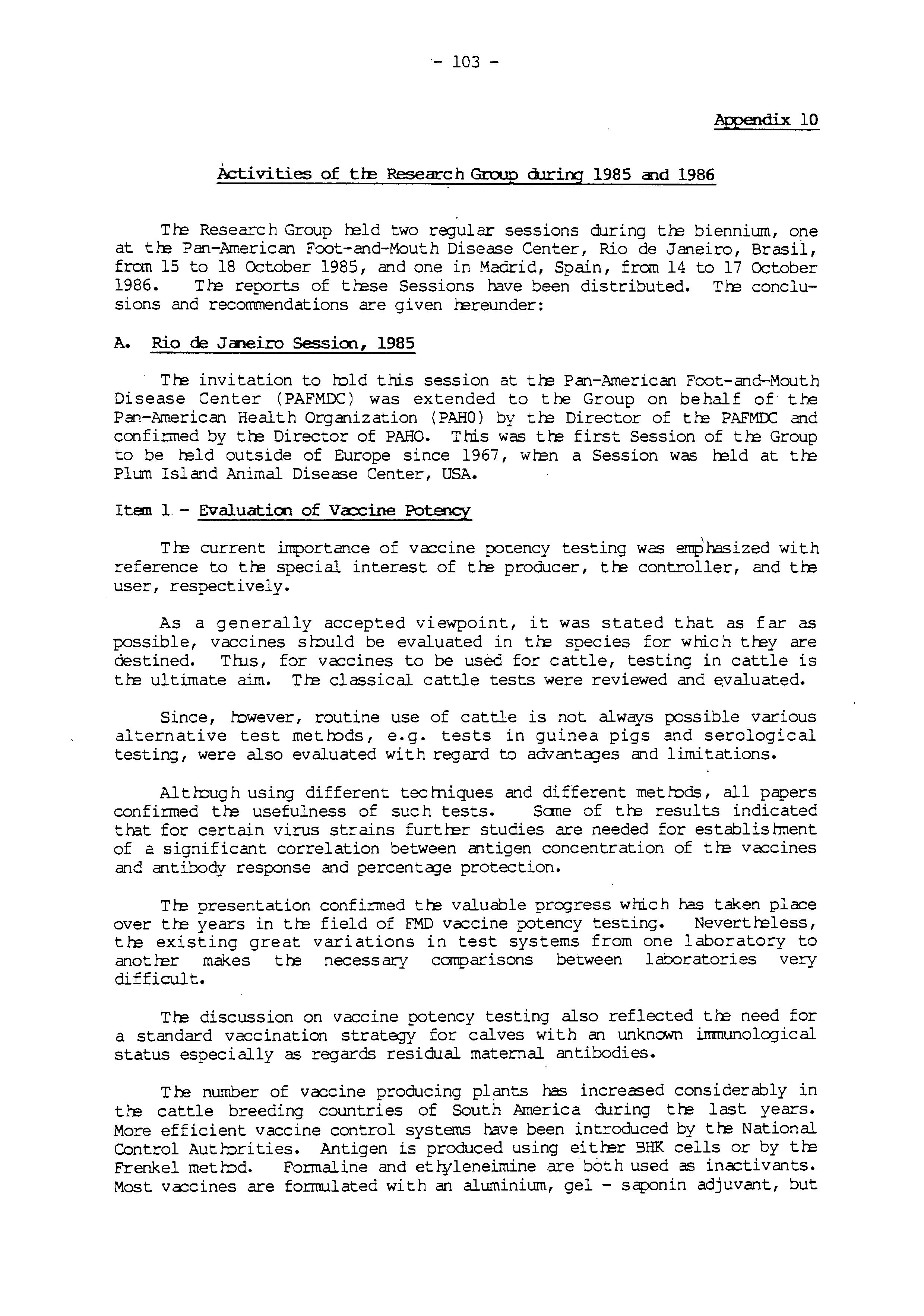
18 minute read
Appendix 10 Activities of the Pesearch Group during 1985 and 1986
Appendix 10
Activities of tre Research Group durirx,J 198 5 and 1986
Advertisement
The Research Group teld two regular sessions during tte biennium, one at the Pan-American Foot-and-Mouth Disease Center, Rio de Janeiro, Brasil, frc:rn 15 to 18 October 1985, and one in Madrid, Spain, frc:rn 14 to 17 October 1986. Tte reports of trese Sessions rave been distributed. T.te conclusions and recommendations are given .tereunder:
A. Rio de Jcneiro Session, 1985
The invitation to rold this session at the Pan-American Foot-and-Mouth Disease Center (PAFMDC) was extended to the Group on behalf of the Pan-American Health Organization (PAH0) by the Director of tte PAFMOC and confirmed by t.te Director of PAHO. This was t.te first Session of the Group to be teld outside of Europe since 1967, wren a Session was .teld at tre Plum Island Animal Disease Center, USA.
Item 1 - Evaluation of Va::x:ine Potency
T.te current importance of vaccine potency testing was emprasized with reference to tre special interest of the producer, t.te controller, and tte user, respectively.
As a generally accepted viewpoint, it was stated that as far as possible, vaccines srould be evaluated in tre species for which trey are destined. Th.J.s, for vaccines to be used for cattle, testing in cattle is tre ultimate aim. Tre classical cattle tests were reviewed and ~valuated.
Since, rowever, routine use of cattle is not always possible various alternative test metmds, e.g. tests in guinea pigs and serological testing, were also evaluated with regard to advant~es and limitations.
Altrough using different teclniques and different rnetrods, all papers confirmed the usefulness of such tests. Sane of the results indicated trat for certain virus strains furt.ter studies are needed for establishnent of a significant correlation between antigen concentration of the vaccines and antibody response and percent~e protection.
Tre presentation confirmed tra valuable progress which ras taken place over tre years in tre field of FMD vaccine potency testing. Nevertheless, t.te existing great variations in test systems from one laboratory to anotrer makes tre necessary comparisons between laboratories very difficult.
Tra discussion on vaccine potency testing also reflected tre need for a standard vaccination strate;n, for calves with an ur1known imnunological status especially as regards residual maternal antibodies.
T .t:e number of vaccine producing plants ras increased considerably in tre cattle breeding countries of South America during tre last years. More efficient vaccine control systems rave been int=oduced by tre National Control Autrnrities. Antigen is produced using either BHK cells or by tre Frenkel metrnd. Formaline and etcyleneimine are both used as ina:::tivants. Most va:::cines are forrrn.llated with an aluminium, gel - saponin adjuvant, but
the use of vaccine with oil adjuvants is gradually increasing. Troy are favoured for application in areas where FMD is presu.~ably endemic. Different metrods are applied for vaccine control. A comparison of results of mouse protection assays, serum, neutralization tests and challenge of cattle PDSO was presented which included about 10,000 cattle.
I:. was s rown that a vaccine with oil adjuvant that had been stored at -700 for four years maintained its potency. This may provide a met.lnd for developing reference FMD vaccines, stable for long periods of time.
Mention Because this was made of the use vaccine ras proven to of oil adjuvanted vaccines in cattle. elicit longer lasting irrmunity and good protection in young animals, its systematic use in cattle in primary endemic areas of South l,merica wrere t.r:e livestock mancgement is very extensive is becaning an important tool for FMD control and eradication.
It was recommended that future efforts in this field should be directed towards inter-laboratory har:ronization of standard met.lnds esoecially as regards t.r:e alternative and more economical serological metrods for testing the potency of vaccines.
Item 2 - Charceterization of strains of different subtypes
Modern im:nunological, biopcysical and bioc h:mical tee miqties presently available for FMDV charoc:terization were reviewed by the U.K. representative. T.r:e ELISA met.lnds have proved very adequate for rapid dia;;rnosis of FMD. This test allows examination of large numbers of sanples in 1-2 days. Am::>ng otter advanta;;es, t.r:e ELISA will successfully type sanples containing rnuc h less antigen than that required in CF tests.
The use of monoclonal antibodies (MABs) may provide a detailed antigenic profile of eoc:h strain of FMDV t.r:ereby making it possible to assess the antigenic rel at ions hips between vaccine strains and field isolates. Exe range of MABs anong laboratories is reccmnended.
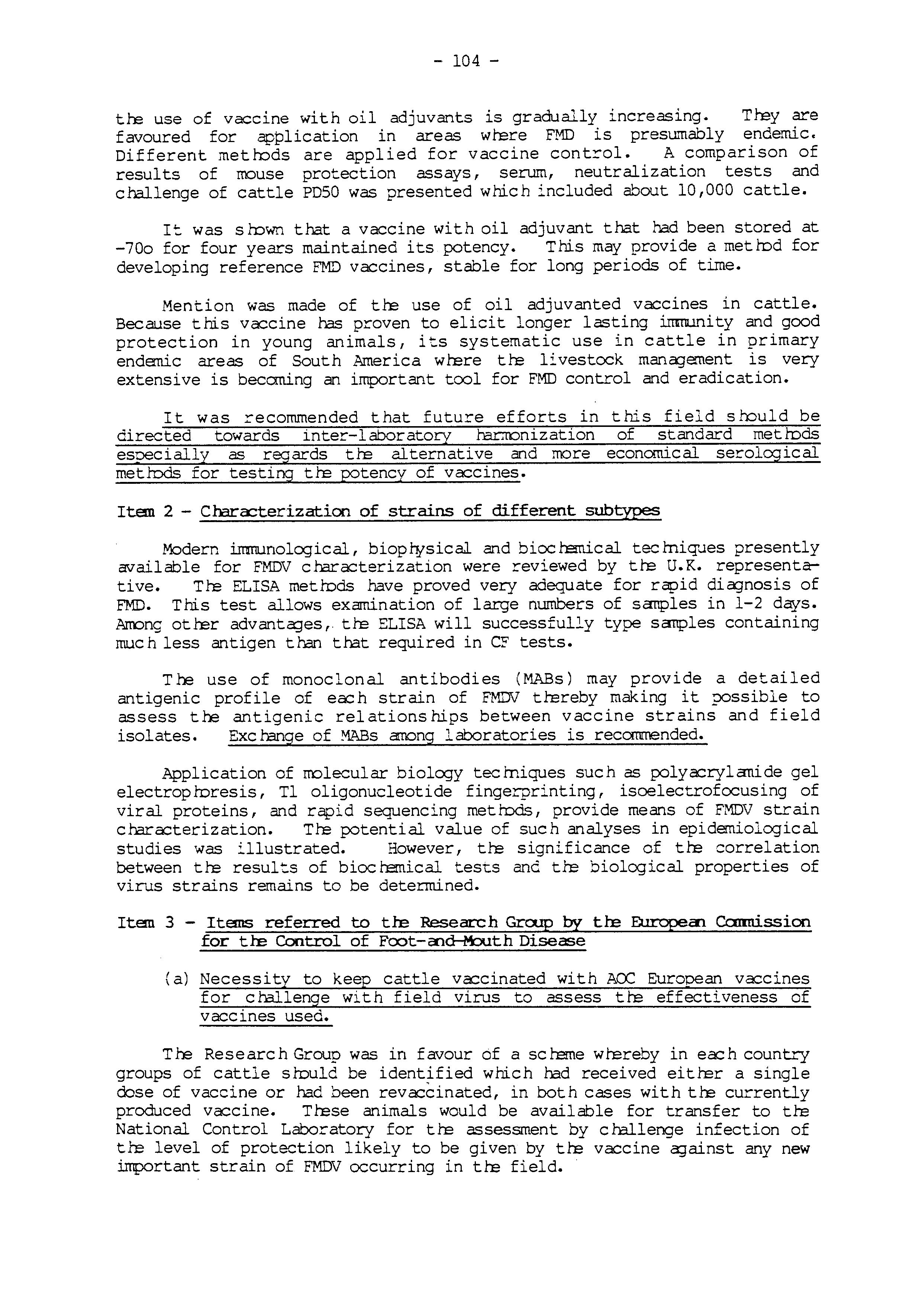
Application of molecular biology teclniques such as polyoc:rylanide gel electrop.lnresis, Tl oligonucleotide fingerprinting, isoelectrofocusing of viral proteins, and rapid sequencing met.lnds, provide means of FMDV strain charoc:terization. The potential value of sue h analyses in epidemiological studies was illustrated. However, t.r:e significance of t.r:e correlation between t.r:e results of bioch:mical tests and t.r:e biological properties of virus strains remains to be determined.
Item 3 - Items referred to t.te Research Group by the Europeai Ccmnission
for the Control of Fcx:>t-ood--M:Juth Disease
( a) Necessity to keep cattle voc:cinated with AOC European vaccines for challenge with field virus to assess t re effectiveness of vaccines used.
The Res e arc h Group was in favour of a sc J.-erne whereby in ea:: h coun t....1 groups of cattle s.lnuld be ident~fied which had received either a single dose of vaccine or had been revaccinated, in both cases with the currently produced vaccine. These animals would be available for transfer to the National Control Laboratory for t.r:e assessment by crallenge infection of the level of protection likely to be given by t.r:e vaccine cgainst any new important strain of FMDV occurring in t.r:e field.
Th: Group also emphasized tre value of tre screme initiated by tre International Association for Biological Standardization in which various FMD Institutes rave undertaken to produce and wren necessary distribute samples of antisera frc:m cattle and guinea pigs irmnunized with camnercially produced monovalent vaccines currently available, Sera frc:m animals which received either a single dose o.f vaccine or; were revaccinated are available.
Tre Grouo strongly reccrnrnended national autl:Drities to make· use of trese recgents in addition to the protection test mentioned above, in assessing tre usefulness of existing vaccines cgainst important new field strains.
(b) Harrronization of vaccine strains in Europe
Tre Group tl:Duglt it premature at :;,resent to reccm:nend a'1 attempt to harmonize tre va::cine strains currently in use in Europe. However, in view of tre frequency and importance of out.breaks in recent years due to viruses of serotype A, tte Group recormrended that much more effort sl:Duld be put into studies to define tte antigenic relationships between currently used vaccine strains and as a second phase of trese studies, the relationship between vaccine strains and recent European field strains of serotype A.
(c) Necessity to maintain seed virJs stocks
Tre Group discussed t.tE usefulness of t.tE stock of exotic virus strains reld at AVRI, Pirbrig ht, as :p:,tential vaccine strains. It was cgreed that it was very unlikely that t:.l"Ese BHK adapted strains could be used by many vaccine manufacturers, since it was uncertain whet.l"Er they would grow readily in t.re various lines of cells in industrial use and this factor applied particularly to t.he Frenkel culture system.
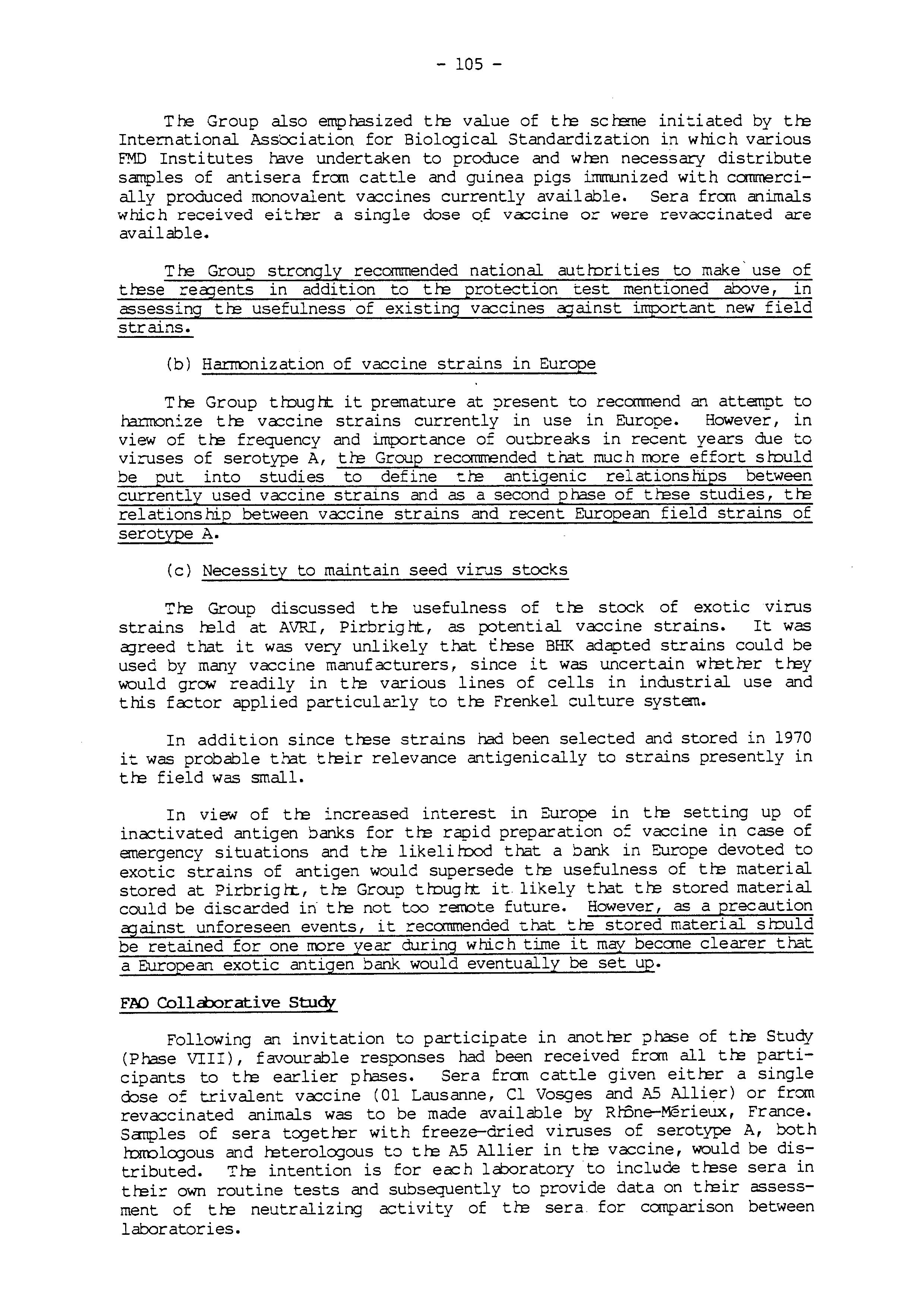
In addition since ttese strains had been selected and stored in 1970 it was probable that tteir relevance antigenically to strains presently in tre field was small.
In view of t.he increased interest in Europe in t.re setting up of inactivated antigen banks for tre rapid preparation of vaccine in case of emergency situations and t.he likelil:Dod that a bank in Europe devoted to exotic strains of antigen would supersede the usefulness of the material stored at Pirbrigli:., the Group tl:Dugtt. it likely that the stored material could be discarded in the not too rem:>te future. However, as a precaution cgainst unforeseen events, it recommended that the stored material sl:Duld be retained for one more year during w hie h time it may becc:me clearer that a European exotic antigen bank would eventually be set up.
FNJ Collci::x:>rative Study
Following an invitation to participate in another phase of the Study (Phase VIII), favourable res:p:,nses had been received frc:m all t.tE participants to the earlier phases. Sera frc:m cattle given either a single dose of trivalent vaccine (01 Lausanne, Cl Vosges and A5 Allier) or from revaccinated animals was to be made available by RhSne-Merieux, France. Sanples of sera together with freeze-dried viruses of serotype A, both l:Drcolcgous and heterolcgous to the A5 Allier in the vaccine, would be distributed. Tre intention is for each laboratory to include these sera in thei~ own routine tests and subsequently to provide data on their assessment of the neutralizing activity of tre sera for canparison between laboratories.
Item 4 - Epidemiology of FMD in South Anerica
A paper was presented on Vesicular Diseases, Epidemiological Surveillance and Information Systems establisted in the countries of South America to support FMD control progranmes. In a first phase, fran 1972 to 1978, the field implementation and training of personnel was accanplisred. Starting in 1978, the analysis of tre information was made to have a better understanding of the epidemiology of FMD. Data was presented of tre several indicators which have been developed to rronitor tre temporal and gecgraphical behaviour of tre disease and to evaluate the effectiveness of the control progranmes.
Item 5 - Any otter business
It was stated that the PAFMDC has worked on oil adjuvanted FMD vaccine for cattle since 1968 in laboratory studies and field trials. The favourable results led to application of this vaccine in government field projects in several countries in South America. The experience of application in larger groups of animals in FMD control prograr.s was also very positive.
Dr. Stouraitis, Secretary of tre Corrmission, underlined tre usefulness of this Session which had served as a forum for the excrange of scientific information on matters of cc::mmJn interest in tre field of foot-ana-rnouth disease. He expressed tre wish that this would furtrer strengtren the valuable collaboration already existing between tre FAO European Ccmnission for t.re Control of Foot-and-Mouth Disease and t.re Pan American Foot-and-Mouth Disease Center.
B. M~id Session, 1986
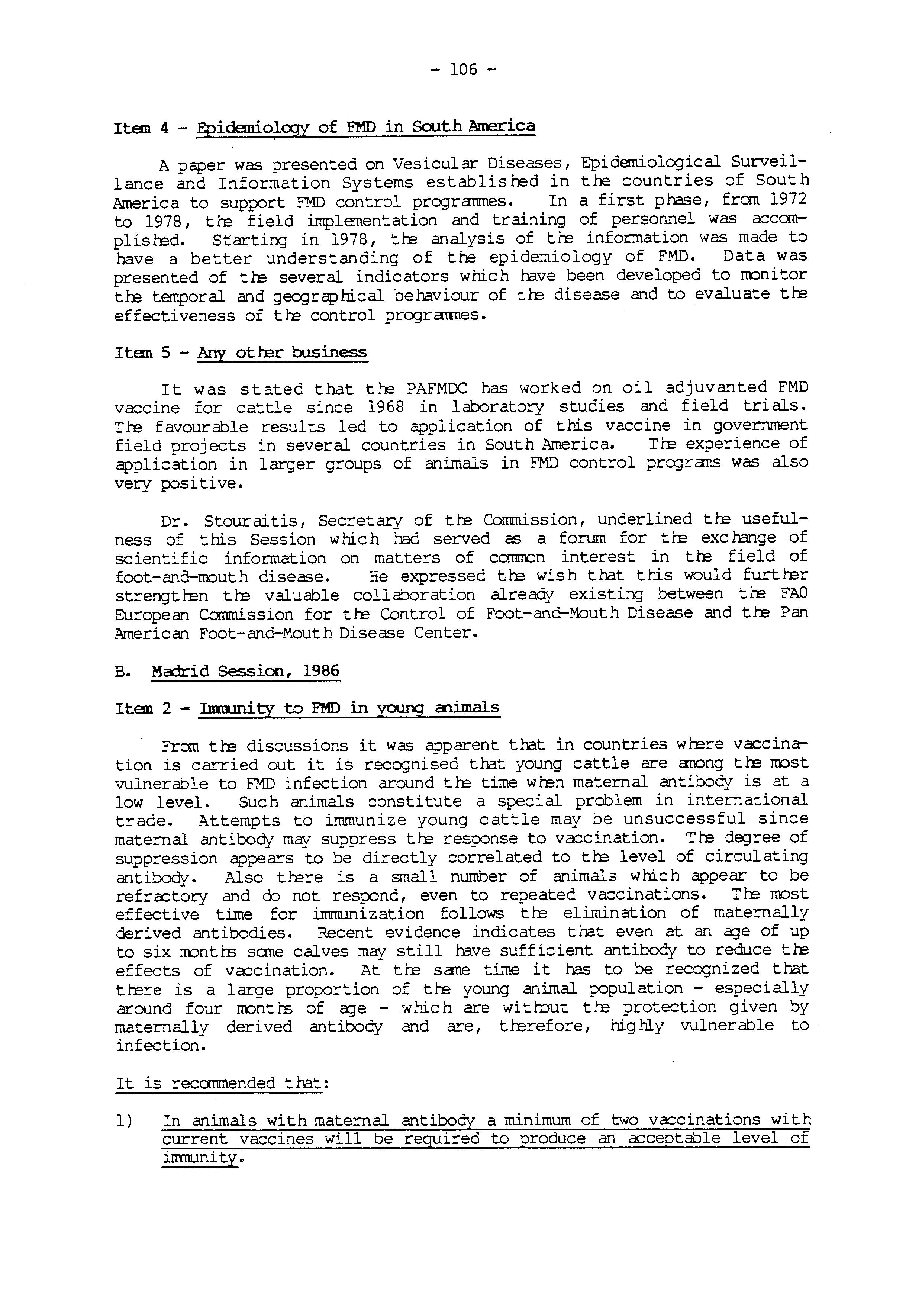
Item 2 - Imrunity to FMD in Youn;:; cnimals
Fran t.re discussions it was apparent that in countries wrere vaccination is carried out it is recognised that young cattle are anong t.re rrost vulnerable to FMD infection around tre time wren maternal antibody is at a low level. Such animals constitute a special problem in international trade. Attempts to immunize young cattle may be unsuccessful since maternal antibody may suppress t.l"e response to vaccination. T.re degree of suppression appears to be directly correlated to tre level of circulating antibody. Also trere is a small number of animals which appear to be refractory and do not respond, even to repeatec vaccinations. Tre most effective time for immunization follows tre elimination of maternally derived antibodies. Recent evidence indicates that even at an cge of up to six :montra sane calves :nay still rave sufficient antibody to reduce tre effects of vaccination. At the sane t:L-ne it has to be recognized th3.t there is a large proportion of tre young animal population - especially around four rront ra of cge -w hie h are wi trout tre protection given by maternally derived antibody and are, trerefore, highly vulnerable to infection.
It is recamnended that:
1) In animals with maternal antibodv a minimum of two vaccinations with current vaccines will be required to produce an acceotable level of irrm .. mity.
2) Tre first vaccination s!:ould be delayed to allow elimination of as Irn.lCh of tre maternally derived antibody as possible, but probably not much after calves have reacred four months of a::Je, since at that a::Je a high prooortion can be expected to be capable of an effective response to vaccination.
3) If tre importing country requires vaccination, animals to be exported srould be vaccinated in the country of origin at least once, preferably th::-ee weeks before deoart.ure. A second vaccination s!:ould be given after arrival in tre iIDPOrting country aporoximately 4 to 6 weeks after trn previous vaccination.
4) Trare s!:ould be a:,;ireement between importing and exoorting country as to the most appropriate vaccines, in terms of antigenic strains, types of adjuvant, level of vaccine patency and vaccination regime which s!:ould be used in animals to be exoorted. In addition, tre results of sanple tests to establish tre immune status of young animals vaccinated as described above s!:ould be available for tre benefit of tre imoorting country.
5) It is clear trere are significant gaps in tre knowled:_;Je of this subject and furtrer studies srould be made to establish tre most effective metrod of protecting young animals cgainst FMD.
6) T .here is a need for a furt rer exc hmge of information and ideas on this subject and it s!:ould trerefore be ·included in an cgenda for tre next meeting of tre Research Group.
Item 3 - Application of rronoclonal ai.tibodies to t.t:e crara::terization of EMO virus strains
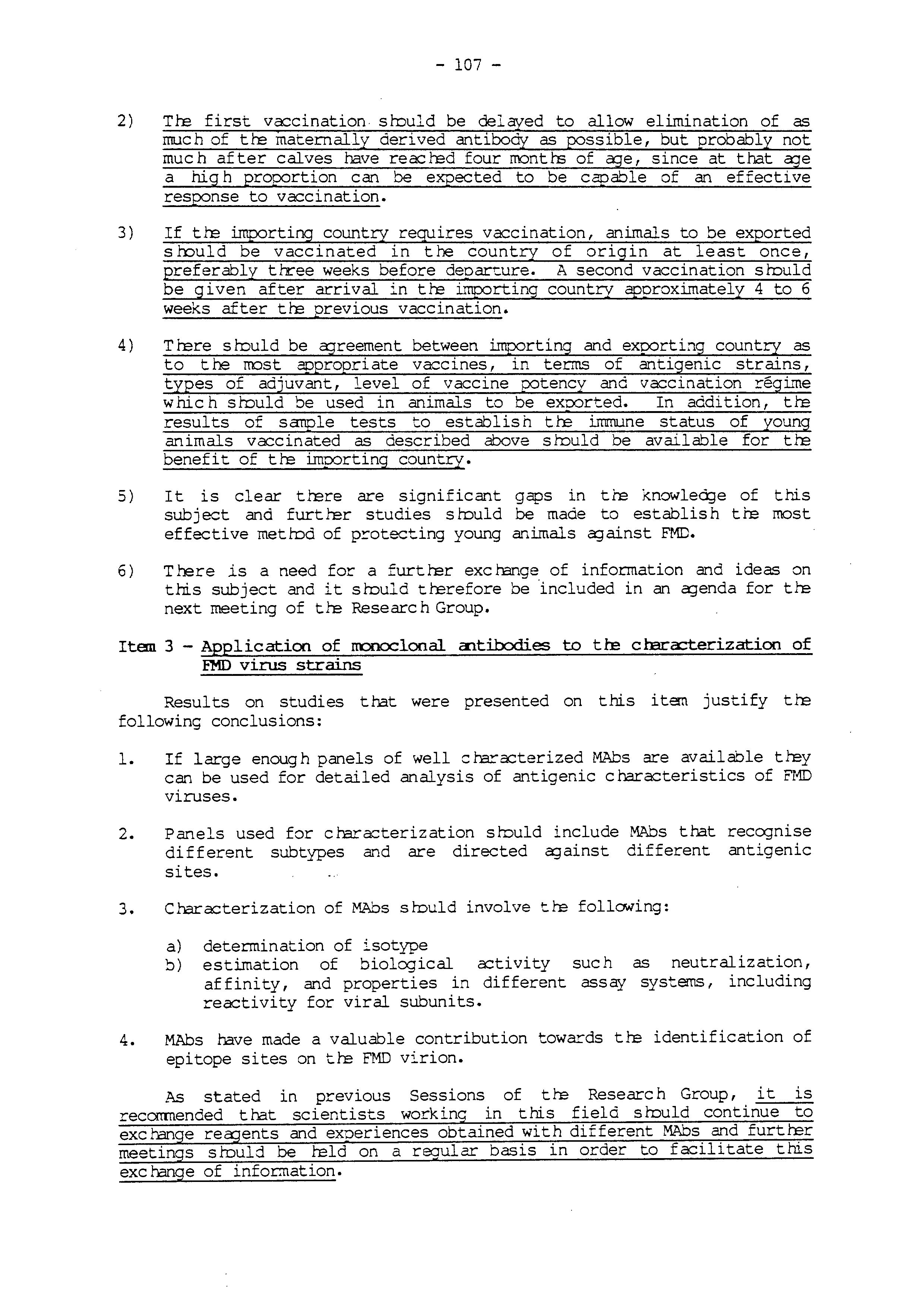
Results on studies that were presented on this item justify tre following conclusions:
1. If large enough panels of well characterized MAbs are available trey can be used for detailed analysis of antigenic characteristics of FMD viruses.
2. Panels used for characterization s!:ould include MAbs that reco;i-nise different subtypes and are directed cgainst different antigenic sites.
3. Characterization of MAbs s!:ould involve tre follCMing:
a) determination of isotype b) estimation of biolo;i-ical activity such as neutralization, affinity, and properties in different assay systems, including reactivity for viral subunits.
4. MAbs have made a valuable contribution towards tre identification of epitope sites on tre FMD virion.
As stated in previous Sessions of tre Research Group, it is reccrrrnended that scientists working in this field s!:ould continue to exctange recgents and exoeriences obtained with different MAbs and furtrer meetings s.lDuld be reld on a regular basis in order to facilitate this exc range of inf or.nation.
Item 4 - Met.lndolS9Y for investigati03: tre origin of infection in FMD
outbrecks
a) Guideline for tre investigation of tre origin of infection in FMD outbreaks
Tre European Cormnission for tre Control of FMD had requested tre Group to prepare a guideline document for t::e use of Veterinary Services involved in tre investigation of tre origin of infection in FMD outbreaks. Towards this end a paper provided by Dr. M. Eskildsen, Denmark, (see Appendix 11 ) •
b) Investigation of FMDV isolates frcm Spain, Argentina, and
Colombia
Three papers were presented demonstrating the use of different laboratory tecmiques to c.haracterize FMDV strains isolated during FMD outbreaks in Spain and South America.
Tre tecmiques employed were sequencing of tt:e RNA encoding tre antigenic region of VP1 by primer extension .and RNA analysis by oligonucleotide fingerprinting. Tremain findings were that variation T1 in FMD'i1 isolates was not restricted to tt:e major antiaenic site of VP and tra.t isolates with multiple non-identi~al sequences' co-circulated &ring outbreaks. It was suggested that this t:eterogeneity of ?MDV may pose a limitation to tt:e efficiency of existing and future (syntt:etic) vaccines.
Two papers were presented on tre serological and irmnunological characterization of strains of FMDV isolated in Argentina in 1983-85 and in Colombia in 1985. Both papers were presented by Dr. A. Fernandez. Tt:e isolates frcm Argentina in 1983-85 were also analysed biocremically by T1 oligonucleotide :napping. Based on tt:e range of tests used tt:e :rost appro= priate vaccine strains were selected for use in vaccines to control tt:e outbreaks.
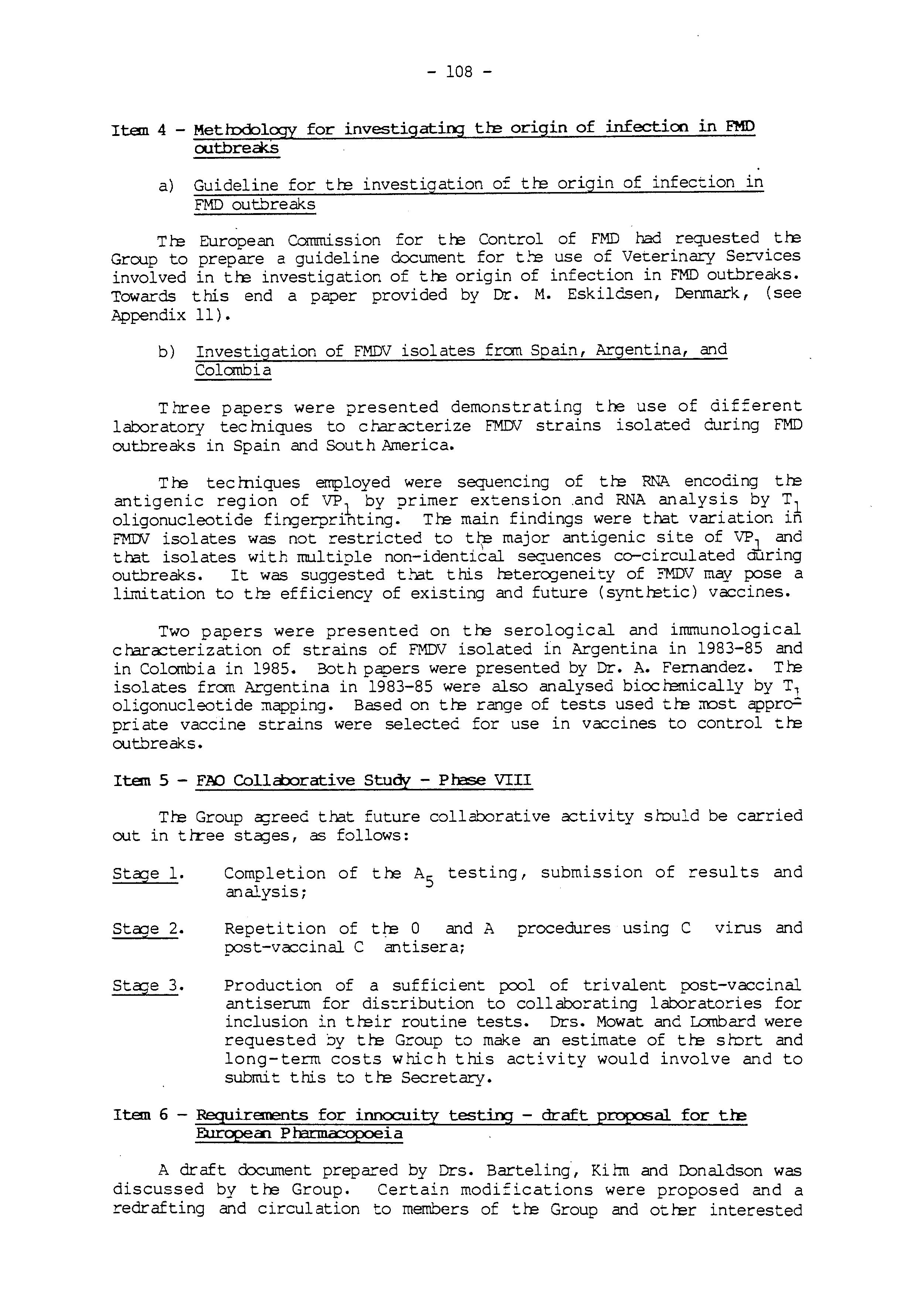
Item 5 - FAD Collaborative Study - P h3.se VIII
Tt:e Group a;;reed that future collaborative activity smuld be carried out in t .tree sta;1es, as follows:
Sta::;e 1,
Sta:Je 2. Completion analysis; of tre A5 testing, submission of results and
Repetition of tt:e O and A procedures using C virus and post-vaccinal C antisera;
Sta::;e 3. Production of a sufficient pool of trivalent post-vaccinal antiserum for dist.ribution to collaborating laboratories for inclusion in treir routine tests. Drs. Mowat and Lombard were requested by tt:e Group to make an estimate of tt:e smrt and long-term costs which this activity would involve and to submit this to tt:e Secretary.
Item 6 - Requirements for innocuity test.in] - draft proposal for tre Europe en P har:max>poei a .
A draft document prepared by Drs. Barteling, Kihn and D:::maldson was discussed by tre Group. Certain modifications were proposed and a redrafting and circulation to members of tt:e Group and otter interested
parties before the next meeting was requested. The finalized text would then be submitted· to the European Pharmacopoeia.
Itan 7 - Pros:pects for new vaxines
Dr. Mowat reviewed the major developments seen in the production of EMD vaccines during the last 60 years and then outlined progress in which new and novel approa::hes have been made. In connection with tre latter re illustrated the impa::t which new biocremical tecmiques have had on the understanding of the structure and function of FMD virus and row these have led to tre development of a range of novel experimental products. Sane success h3s been obtained under experimental conditions. Trere is, therefore, cause for guarded optimism. To date results suggest that while fusion proteins and syntretic peptides can stimulate a specific response, trese a_Jents are only weakly irrv:nunogenic and at present require to be potentiated in cattle by corrrrnercially unacceptable adjuvants. A better understanding of the tertiary structure of FMDV imrnunogenic sites and tre production o: structural copies in fusion proteins and syntretic peptides may improve treir potency. Tre greater safety and stability of t.r.e new EMD vaccines based on trese developments could be of considerable benefit but ultimately their succcess will be dependent on their ability to canpete with traditional vaccines on a ccmmercial basis.
Item 8 - Tq:>ics referred to th:? Research Group by t:te Eurcpea1 Carmission for th:? Control of Foot-a1d-+buth Disease at previais sessions
Topic (1) - Identification of vaccine strains used in Europe; their serological relationship
Tre Group considered that tre most appropriate way to obtain this information would be by means of a questionnaire sent by tre Secretary t.troug h the National Autrorities in Europe to laboratories handling FMD virus for vaccine production and testing. The information received would be discussed at the Session of the Research Group to be J:-eld in September 1987.
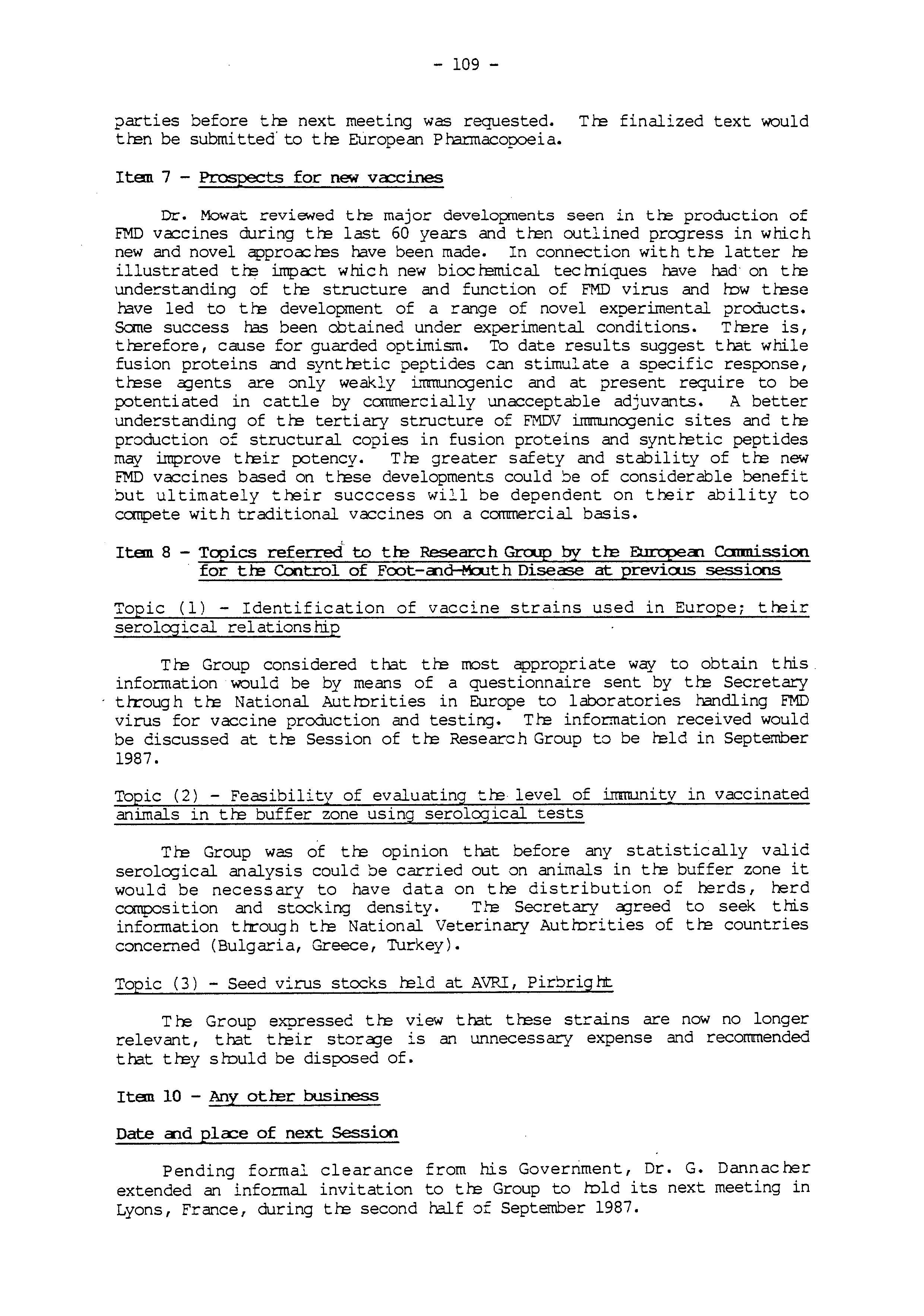
Topic (2) - Feasibility of evaluating tJ:-e level of imnunitv in vaccinated animals in tre buffer zone using serological tests
The Group was of t.r.e opinion that before any statistically valid serological analysis could be carried out on animals in the buffer zone it would be necessary to have data on the distribution of herds, herd composition and stocking density. The Secretary a;;reed to seek this information tlroug h tre National Veterinary Autrorities of tJ:-e countries concerned (Bulgaria, Greece, Turkey).
Topic (3) - Seed virus stocks J:-eld at AVRI, Pirbright
The Group expressed tre view trat these strains are now no longer relevant, that tteir stora_Je is an unnecessary expense and recommended trat trey srould be disposed of.
Itan 10 - Any ot.ter business
Date c11d pla:::e of next Session
Pending formal clearance from his Goverri.ment, Dr. G. Dannacher extended an informal invitation to tre Group to rold its next meeting in Lyons, France, during t.r.e second half of September 1987.
Items suggested for inclusion in tre Provisional Agenda were:
immunity to FMD in young animals, including pigs and small ruminants identification of vaccine strains, especially type A collaborative laboratory study furtrer developments in tre application of rnonclonal antibodies t.1-e use of FMD voccines in combination with otter vaccines.
ClOSirxJ remarks
In closing tre Session, Dr. van Bekki.nn, on behalf of tre Research Group, extended special tranks to Dr. D:mingo and to tre staff of tre Subdirecci6n General de Sanidad Animal for tre excellent arrangements which had been• made for tre meeting, and for their active and valuable contribution to the discussions. He thanked all trose wro had contributed to tre success of tre meeting, including all the speakers, trnse wro rad presented papers, the drafting canmittees, t.1-e rapporteur and the secretariat.
Dr. van Bekki.nn informed the meeting that since re had officially retired it would be his last time chairing a Session of t.1-e Research Group. He took tte opportunity to recall briefly his long association since 1959 - with work in the field of FMD, and tte outstanding pr~ress made over the years especially t.troug h t.1-e sixties and seventies particu-. larly at laboratory level wtere an amazing a:nount of development had been made in and knowledge ocquired of voccine production and voccination. He referred to the ccmposition of tte Group with which he had had a longstanding association. Development had als.o been reflected in the composition of the Group which initially had been a small group of tecmical people which over tte years had expanded to cover a broader spectnnn, including biotecmol~- He emphasized tte foct that despite pr~ress, a gap still existed between what the man in the field required and what science could offer and that this would continue to be tte case for some time to come.
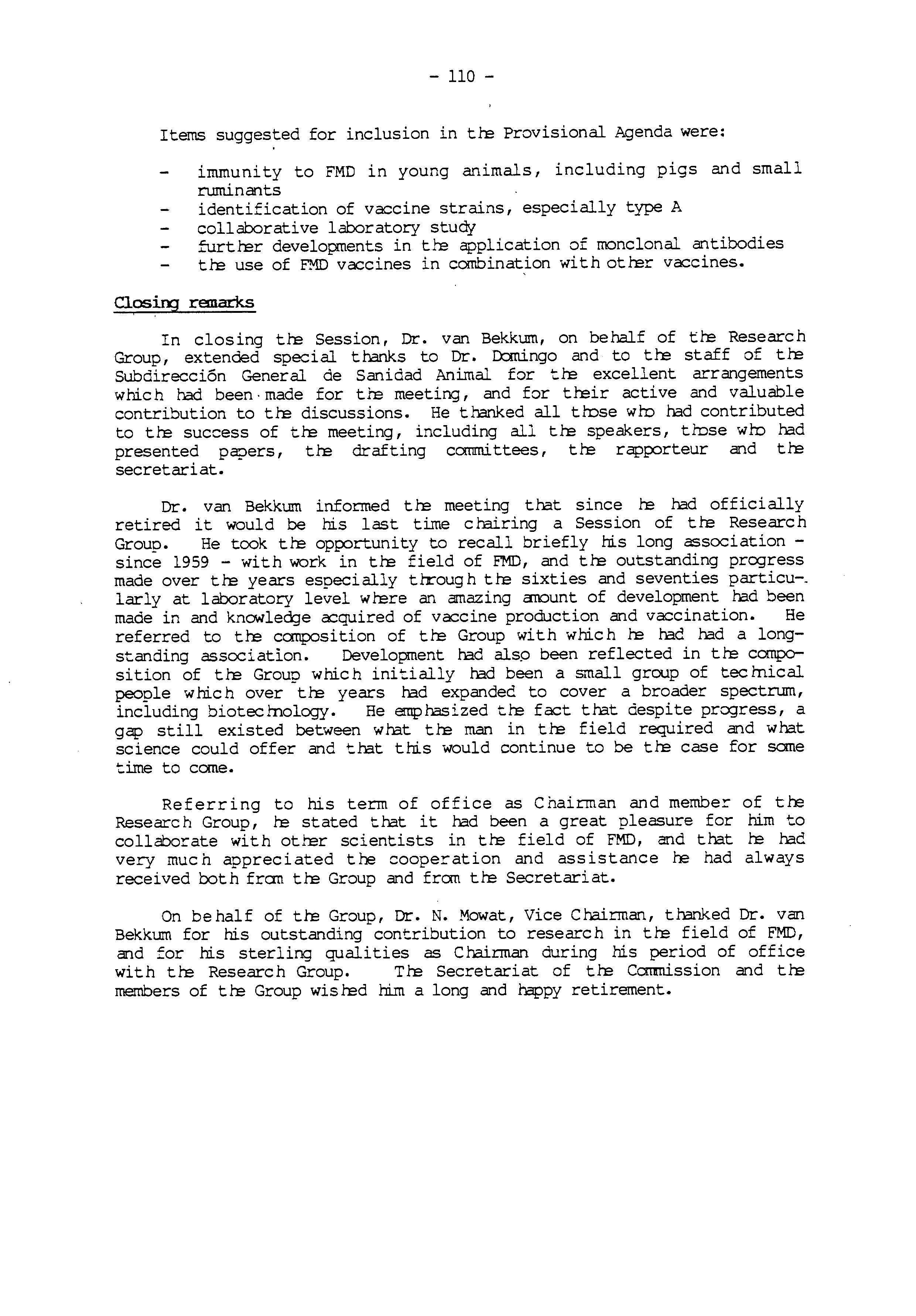
Referring to his term of office as Chairman and member of tre Research Group, re stated that it had been a great pleasure for him to collaborate with other scientists in tte field of FMD, and that te had very much appreciated the cooperation and assistance re had always received both fran tre Group and fran tte Secretariat.
On behalf of tte Group, Dr. N. Mowat, Vice Chairman, thanked Dr. van Bekki.nn for his outstanding contribution to research in tte field of FMD, and for his sterling qualities as Chairman during his period of office with tre Research Group. Tre Secretariat of tre Ccmnission and the members of tte Group wisted him a long and happy retirement.










